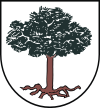 Alternate names: Sośnicowice, Kiefernstädtel, Kieferstädtel, a town in Gliwice County, Silesian Voivodeship, Poland, with 1,776 inhabitants (2004).Gmina Sośnicowice is an urban-rural administrative district in Gliwice County, Silesian Voivodeship, in southern Poland with its seat in the town of Sośnicowice, 10 km (6 mi) W of Gliwice and 34 km (21 mi) W of the regional capital Katowice. The gmina 2006 total population is 8,249 (out of which the population of Sośnicowice amounts to 1,747. The gmina contains part of the protected area called Rudy Landscape Park. Apart from the town of Sośnicowice, Gmina Sośnicowice contains the villages and settlements of Bargłówka, Gajówka, Kozłów, Kuźniczka, Łany Wielkie, Nowa Wieś, Podlesie, Rachowice, Sierakowice, Sierakowiczki, Smolnica, Trachy, Tworóg Mały, Wesoła and Zamoście. [July 2009]
Alternate names: Sośnicowice, Kiefernstädtel, Kieferstädtel, a town in Gliwice County, Silesian Voivodeship, Poland, with 1,776 inhabitants (2004).Gmina Sośnicowice is an urban-rural administrative district in Gliwice County, Silesian Voivodeship, in southern Poland with its seat in the town of Sośnicowice, 10 km (6 mi) W of Gliwice and 34 km (21 mi) W of the regional capital Katowice. The gmina 2006 total population is 8,249 (out of which the population of Sośnicowice amounts to 1,747. The gmina contains part of the protected area called Rudy Landscape Park. Apart from the town of Sośnicowice, Gmina Sośnicowice contains the villages and settlements of Bargłówka, Gajówka, Kozłów, Kuźniczka, Łany Wielkie, Nowa Wieś, Podlesie, Rachowice, Sierakowice, Sierakowiczki, Smolnica, Trachy, Tworóg Mały, Wesoła and Zamoście. [July 2009]
Jews settled in Sośnicowice, called Kieferstadtel before WWII, in the early 19th century as a small percentage of the local population. In 1861 57 Jews lived with about a thousand inhabitants. As Hitler came to power, local Jews gradually began to leave until in 1938 none remained. [July 2009]
CEMETERY: On the current ul Gimnazjalnej, the small cemetery was established in 1848 was surrounded by a high wooden fence, with no more than fifty traditional matzevot. At the entrance was a small wooden caretaker building. During Kristallnacht cemetery was vandalized and the wooden building burned. During WWII, the Nazis used the gravestones for paving near the post office. After liberation, locals stole gravestones. Today, only fragments of gravestones remain. One broken into 3 parts, sandstone, rectangular gravestone with a triangular top remains and dates from 1848 (5608), the son of Menachem Mendel Zewa Wolf Hotzen. The grass obscures the gravestone signed by a workshop from Gliwice. Drive from the market toward Rud Raciborskich. At the football field, turn left. Among the fields about 0.5 km from the main road and about 100 meters from ul Gimnazjalnej is the cemetery. Video. photos. [July 2009]US Commission No. AS 185
Alternate German names: Kieferstaedtel and Sosniessowitze. Town is located in the Katowickie region along the dirt road from Raciborsha or Gliwicka Streets, 10 km from Guwic and 35 km from Katowic. The cemetery location is among the fields. Present population is 1,000-5,000 with no Jews.
- Town: Urzad Gminy, Rynek 19, Kod. 44-153, Naczelnik sekv., tel. 38-71-91 and Refevat Gospodavki terenowej, tel. 38-75-50.
- Regional: Panstwowa Sluzba Ochrony Zabytkow Odoziat region Wkatowicach, 31 Witastwosza St., Kod 40-042, tel. 51-86-07.
The earliest known Jewish community was 1853. 1869Jewish population was 29. The Jewish cemetery was established in 1848 and the community in 1853 with last Conservative burial in 1938. The community of Sosnicowice also used this cemetery. [sic] The isolated rural crown of a hill has no sign or marker, no wall or fence, no gate. Reached by turning directly off a public road, access is open to all. The cemetery size before WWII and now is about 25 m X 13 m. Eight sandstone finely smoothed Hebrew inscribed stones in original location and 2 not are 25%-50% toppled or broken [OR 9 stones.] Tombstones date from 1848-20th centuries. There are no known mass graves. The municipality owns property used for agriculture. Adjacent properties are agricultural. Rarely, local residents visit. The cemetery was vandalized occasionally. There is no maintenance, care or structures. Weather erosion, vegetation, incompatible nearby existing and planned development are slight threats. Security and vandalism are moderate threats.
Dariusz Walerjanski, 11/6 Sleczka St., 41-800 Zabrze, tel. 171-32-60 completed survey on 05/09/94 after a visit on 05/04/94. Locals were interviewed for this survey.
They Lived Among Us: Polish Judaica, a travel brochure: Arline Sachs, This email address is being protected from spambots. You need JavaScript enabled to view it.
BOOK: Gruber, Ruth Ellen. Jewish Heritage Travel A Guide to East-Central Europe. New York: John Wiley & Sons, Inc., 1992. p. 78
